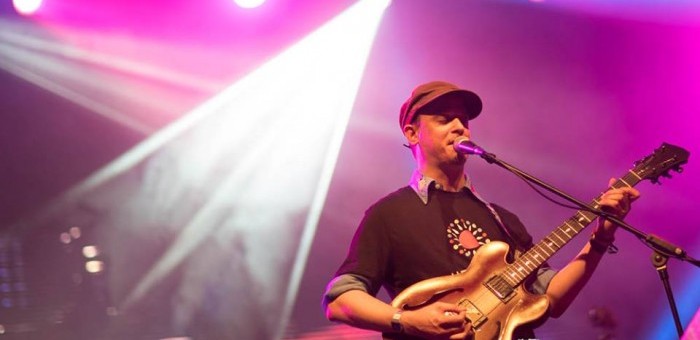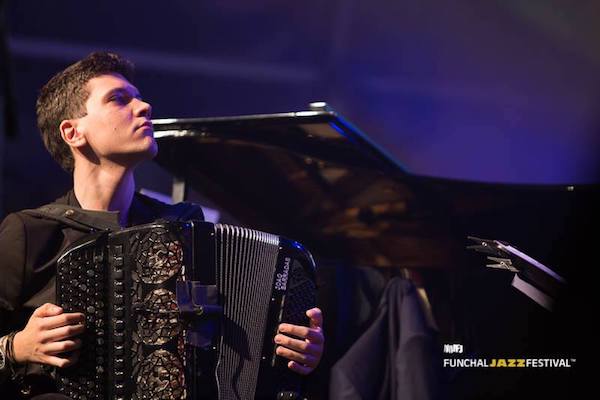Apr 2, 2024 12:59 PM
Saxophonist, Sonic Explorer Casey Benjamin Dies at 45
Casey Benjamin, the alto saxophonist, vocalist, keyboardist and producer who stamped his distinctive sounds on the…

Kurt Rosenwinkel performs during the Funchal Jazz Festival in Madeira, Portugal.
(Photo: Courtesy Funchal Jazz Festival/Facebook)The Funchal Jazz Festival, which transpires annually in the capital city of Madeira, a Portuguese island about 250 miles due west of Morocco, is a well-curated event overseen by artistic director Paolo Barbosa, a Madeiran high school biology teacher and jazz history professor who understands a thing or two about how the personal histories that fuel the narratives portrayed by world-class improvisers can intersect.
An example of this principle manifested at the top of the first concert at Santa Catarina Gardens on the first night of Funchal’s 18th edition (Acosta’s fourth), as 25-year-old João Barradas improvised on button accordion to the pitches and rhythms of a verbal dialog between Wayne Shorter and Joe Lovano about the pleasures of, as Shorter put it, “drawing on all the sounds that exist in the world.”
Barradas executed a brief fanfare as Shorter said, “Leave some room for the accordion!” Then, as Lovano riposted, “It’s the spirit of the players that translate your expressive ideas ...,” he cued a brief drum solo by Bruno Pedroso, and left a few bars of silence as Lovano finished, “...to whatever it is that you play, and the fantasy and imagery that comes through.”
This was an apropos metaphor for what Barradas, who usually plays trio with Pedroso and bassist André Rosinha, accomplished with a strong sextet: fellow Portuguese musicians João Paulo Esteves da Silva on piano and André Fernandes on guitar, along with alto saxophonist Greg Osby, whose imprint label, Inner Circle, released Barradas’ early 2017 album Directions, on which Gil Goldstein and Sara Serpa join the aforementioned personnel.
Titled “Expressive Idea/Unknown Identity,” the opening piece began with all members playing their sounds as Da Silva articulated a disjunctive Andrew Hill-like melody. It coalesced into a freeboppish swing motif over which Barradas played a fleet, saxophonistic line. The time broke apart, a pause ensued, Barradas and Osby played a fleet one-voice unison. Osby broke off into an improvisation of shifting densities and rhythms, setting up his protégé’s solo, in which the accordionist mirrored Osby’s tonality and phrasing at high velocity while also comping for himself. He switched into a not-quite-rubato section, then reaccelerated, weaving in and out of the rhythm with compression-and-release figures.

João Barradas (Photo: Courtesy Funchal Jazz Festival)
Throughout the remaining five numbers, Barradas deployed prodigious chops towards entirely musical ends. On “Letter To Mother’s Immersion,” a simmering Astor Piazzolla-esque tango, he followed a piano-guitar dialog with winding lines over Pedroso’s fragmented beats, ending with a pointillist passage. He switched to Midi accordion on “Varazdin’s Landscape”—it began with a rubato a cappella introduction that evoked the tones of harpischord and organ before the tempo settled into a medium-slow groove that propelled Osby into several choruses on which he navigated the alto’s lower register with pellucid tone. There followed an interweaving alto-accordion section in which it was hard to distinguish one timbre from the other. Da Silva unfurled a lovely, romantic solo episode, then improvised as the group developed his motif, then cued Barradas into a guitaristic, percussive solo.
Imperatives of tonal conversation and sonic speculation infused the remainder of the set, comprising “The Red Badge Of Courage,” “Manners Of Normality” and “Ignorance,” on which Barradas displayed an admixture of formidable chops, rhythmic legerdemain, a comprehensive vocabulary spanning Bach to Bird to ... well, Osby …, and an unfailingly compositional sensibility.
While Osby, 57, was the elder statesman of Barradas’ band, he was the youngest member of Saxophone Summit, in which, for about a year, he has shared the front line with elder road warriors Dave Liebman (playing exclusively soprano saxophone), Joe Lovano (playing exclusively tenor saxophone), Phil Markowitz (piano), Cecil McBee (bass) and Billy Hart (drums). Osby’s structural proclivities, conceptual risk-taking, high chops and individuality fit seamlessly with this singular, long-standing unit, whose members bring over 250 years of experience as professional improvisers to every performance. (Hart himself has shared bandstands with both Liebman and McBee for some 45 years; with Lovano for close to 30 years.)
They opened with a “What Is This Thing Called Love” medley that referenced contrafacts of the Cole Porter classic by Tadd Dameron (“Hot House”) and Lee Konitz (“Subconscious-Lee”). Goosed by Hart’s forceful in-the-moment swinging (at one point, a powerful stroke disabled the snare drum), Liebman flew through the changes with wild shapes; Osby began deliberately, parsing the notes in Konitzian fashion, postulating fresh ideas each chorus; Lovano, in a “Hot House” mood, played with altissimo atmospherics, swooping up and down the tenor; Markowitz was orchestral and kaleidoscopic.

Benjamin possessed a fluid, round sound on the alto saxophone, and he was often most recognizable by the layers of electronic effects that he put onto the instrument.
Apr 2, 2024 12:59 PM
Casey Benjamin, the alto saxophonist, vocalist, keyboardist and producer who stamped his distinctive sounds on the…

“He’s constructing intelligent musical sentences that connect seamlessly, which is the most important part of linear playing,” Charles McPherson said of alto saxophonist Sonny Red.
Feb 27, 2024 1:40 PM
“I might not have felt this way 30 to 40 years ago, but I’ve reached a point where I can hear value in what people…

Albert “Tootie” Heath (1935–2024) followed in the tradition of drummer Kenny Clarke, his idol.
Apr 5, 2024 10:28 AM
Albert “Tootie” Heath, a drummer of impeccable taste and time who was the youngest of three jazz-legend brothers…

“Both of us are quite grounded in the craft, the tradition and the harmonic sense,” Rosenwinkel said of his experience playing with Allen. “Yet I felt we shared something mystical as well.”
Mar 12, 2024 11:42 AM
“There are a few musicians you hear where, as somebody once said, the molecules in the room change. Geri was one of…

Henry Threadgill performs with Zooid at Big Ears in Knoxville, Tennessee.
Apr 9, 2024 11:30 AM
Big Ears, the annual four-day music celebration that first took place in 2009 in Knoxville, Tennessee, could well be…